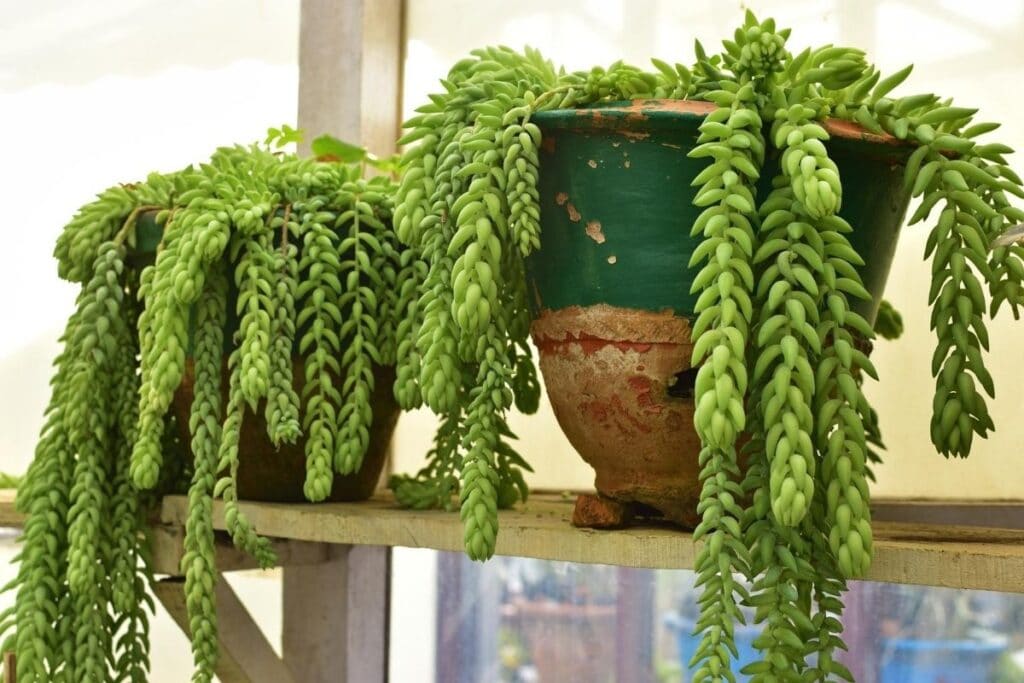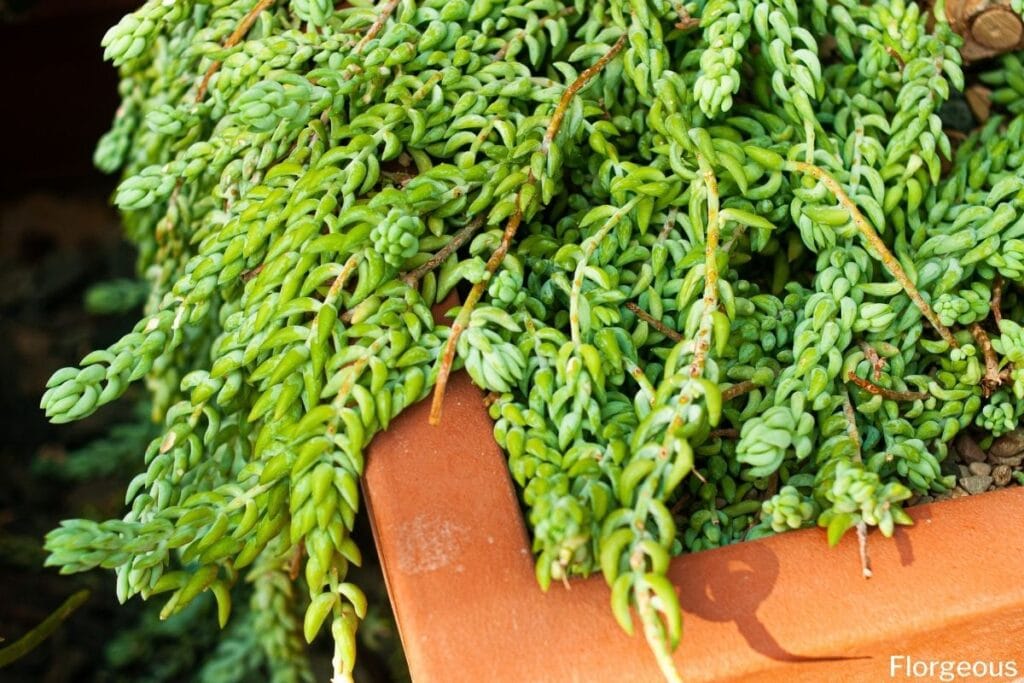Burro’s tails are the perfect specimen either as hanging plants for indoors or trailing plants in rock gardens. The forgiving nature and beautiful cascading habit of this plant is enough to gain it the popularity it very well deserves.
Looking to add burro’s tail to your collection? Read below to see how to care for this wonderful succulent.
What is a Burro’s Tail?
Sedum morganianum, more commonly known as burro’s tail, is a perennial plant from the succulent plant family, Crassulaceae. It is native to southern Mexico, and Honduras where it can be found growing in rocky outcroppings. The plant is also known as donkey’s tail, horse’s tail, or lamb’s tail because of its resemblance to the animal appendage (1).
Burro’s tails grow very long. Their stems can reach up to 4 ft in length. Along these stems, fleshy, blue-green, teardrop-shaped leaves grow in tightly packed, overlapping rows. Each stem could have a hundred leaves, making the stems droop downward.
This cascading habit makes burro’s tails perfect for rock gardens or as hanging indoor plants. Although not common for the cultivated ones, burro’s tails bloom every summer. The beautiful pink to red colored flowers grow at the tip of each stem. (2, 3)

How to Take Care for Burro’s Tail
Burro’s tails are easy to care for houseplants. They can thrive well even when left to fend for themselves. In fact, too much handling of the plant can cause the plump leaves to fall off. But of course, the best results can be achieved when they are cared for keenly.
How Much Light Does Burro’s Tail Need?
Burro’s tail loves full sun. Place them in a spot next to the window where it can receive lots of bright light. You can opt for an eastern window for a half-day exposure because the harsh afternoon sun can burn the leaves (4).
How often Should You Water Burro’s Tail?
The best thing about burro’s tails is their tolerance to drought. They do well even if you forgot to water them. They prefer dry soil and would develop rot if there is too much moisture, so water them moderately.
Make sure that the surface of the soil is dry to the touch before the next watering. Weekly watering can be done during growing seasons (spring and summer) while for winter, monthly watering should be enough (5).
What is the Optimum Temperature and Humidity for Burro’s Tail?
Burro’s tails do not do well with extreme heat. Low to average temperatures ranging from 65 – 75oF (18- 23oC) in daytime, and 55-65oF (12o-18oC) in nighttime is best for these succulent plants.
For winter months, maintain temperatures between 55-65oF day and night. These plants can tolerate dry air and make sure to keep them from draft because it can cause the leaves to fall off (1,5).
What is the Best Growing/Potting Media for Burro’s Tail?
Burro’s tail prefers a well-draining and slightly acidic organic soil. Commercial cactus and succulent potting soil is enough for you plants to thrive but if you want to create your own potting media, a 1:1:1 ratio potting mix, coarse sand, perlite mix will also be perfect (4).
Does Burro’s tail need Fertilizer?
These plants can benefit from the occasional feeding. Apply a balanced organic fertilizer once a month during spring and summer. Stop feeding in winter when your plants become dormant (5).
Propagating Burro’s Tail
If you want to multiply your burro’s tail, you can easily do so through stem tip cuttings and leaf cuttings. For stem tip cuttings, simply cut a portion of the tip with at least 3 leaf nodes. Let the cut section to dry. It will form a callous where the roots are grown.
Once rooted, plant in cactus and succulent potting soil. For leaf cuttings, choose the medium sized leaves or the ones that have fallen by themselves and simply let them form a callous and root and then pot them (6).
This plant can become heavy through time, so when potting burro’s tail as hanging succulent plants, make sure that the pot is durable, and the rope is strong enough to support the weight of the plant.
References
Reference list
1. Murphy D.M. Duea A.W. “The Complete Guide to Growing Windowsill Plants: Everything You Need to Know Explained Simply”. Atlantic Publishing Company. 2011. PP 61-62.
2. Baldwin D.L. “Succulent Container Gardens: Design Eye-Catching Displays with 350 Easy-Care Plants”. Timber Press. 2010. P 122.
3. Horvath B. “The Plant Lover’s Guide to Sedums”. Timber Press. 2014. P 28.
4. Staehling A. “Happy Houseplants: 30 Lovely Varieties to Brighten Up Your Home”. Chronicle Books. 2017. P 42.
5. Deardoff D. Wadsworth K. “What’s Wrong With My Houseplant?: Save Your Indoor Plants With 100% Organic Solutions”. Timber Press. 2016. PP 215-217
6. Sibley E. “The little Book of Cacti and Other Succulents”. Hardie Grant Publishing. 2017.
Close
Photo by depositphotos.com/[email protected]







